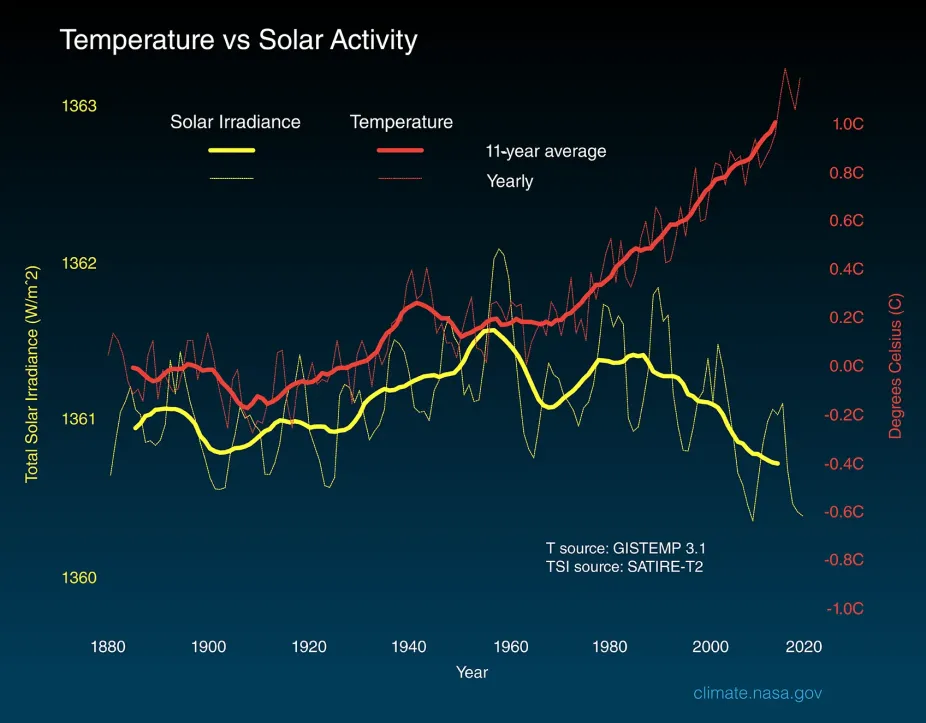The Sun and Climate Change
Earth’s climate is warming due to human activities that increase the amount of greenhouse gases in the atmosphere - not because of the Sun. The Sun does influence Earth’s climate, and the amount of energy that reaches Earth from the Sun does change over time, but only by a fraction of a percent (0.1% over an 11-year sunspot cycle, to be exact). These very small variations in solar energy output and the current orientation of Earth relative to the Sun do not account for the climate warming trend we have been experiencing since we began burning fossil fuels and increasing the amount of carbon dioxide in the atmosphere.
How Does the Sun Influence Earth’s Climate?
The Sun is the source of energy that drives Earth’s climate system. Solar radiation warms the atmosphere and produces global wind patterns due to the uneven distribution of solar energy across the planet’s surface (because of Earth’s spherical shape and the tilt of its axis). Cloud formation, precipitation, and temperatures at different locations on Earth are all directly influenced by the Sun. Solar energy drives photosynthesis in ocean and land plants, which can influence the drawdown of carbon dioxide from the atmosphere and help cool the climate.
Thus, the Sun is largely responsible for Earth’s climate. Climate changes caused by the Sun take place over much longer spans of time, hundreds of thousands of years, versus the rapid warming we have been experiencing in recent decades.

The Sun is 93 million miles from Earth, yet it still provides us with all the energy needed to sustain life.
NASA
Changes In the Amount of Solar Energy Reaching the Earth Are Not Causing Climate Change
Scientists have been monitoring the Sun long enough to observe that there has not been a drastic increase in the amount of solar energy reaching the Earth’s upper atmosphere, called solar irradiance, that would cause the rapid warming we are currently experiencing. In fact, NASA satellite observations suggest that solar irradiance has actually been decreasing over the past 40 years or so. The graph below shows that the trend of increasing global temperature does not follow the trend for solar irradiance.
The amount of energy the Sun produces varies over an 11-year cycle. At the peak of the cycle, called the solar maximum, the Sun is extremely active, with many sunspots and solar storms. After the peak, solar activity decreases for about 11 years until it reaches the solar minimum. Even accounting for these small ups and downs in solar activity, there is not enough of an increase in recent solar irradiance that explains current climate warming.

The amount of solar energy Earth receives (the yellow line on the graph) has followed the Sun’s natural 11-year cycle of maximums and minimums with no net increase since the 1950s. Over the same period, global temperature (the red line on the graph) has risen markedly. It is, therefore, extremely unlikely that the Sun has caused the observed global temperature warming trend over the past half-century. The lighter/thinner lines show the yearly levels, while the heavier/thicker lines show the 11-year average trends. Eleven-year averages are used to reduce the year-to-year natural noise in the data, making the underlying trends more obvious.
NASA
Changes in Earth’s Orbit Around the Sun Are Not Causing Climate Change
There are periodic changes to Earth’s orbit that influence our climate, however the amount of climate warming we are currently experiencing cannot be explained by these predictable orbit cycles. The Earth's three unique orbital cycles are referred to as eccentricity, obliquity, and axial precession.
Eccentricity
Earth’s orbit around the Sun is influenced by the gravitational pull of other planets in our solar system. The gravity of other planets pulls on Earth just enough to change the shape of our path around the Sun from circular to elliptical. The shape of Earth’s orbit, referred to as eccentricity, elongates from circular to elliptical and back again about every 100,000 years. When the orbit is at its most elongated shape, and Earth is positioned farthest away from the Sun, 23% less solar energy reaches our planet. Earth is currently at its least elliptical eccentricity; however, the change in orbital shape happens so gradually that it cannot explain the rapid recent climate warming we are experiencing.
Obliquity
Earth is tilted on its axis, currently at a 23.4° angle. However, the angle of tilt, or obliquity, changes over a 41,000-year cycle. The change in obliquity is enough to affect the amount of sunlight that reaches different latitudes and changes the climate. The Earth is currently about halfway between the maximum and minimum tilt.
Axial Precession
The Earth “wobbles” on its axis, influenced by the gravitational pull of the moon and the Sun, in a 26,000-year cycle, called the axial precession. This wobble changes the direction of the axis, which affects the length of seasons and influences the climate over long periods of time.
Together, these periodic changes in Earth's orbit are referred to as Milankovitch cycles. The effect on Earth’s climate due to each cycle on its own is small. However, taken together, they do account for predictable climate changes that span thousands of years. When the orbit is elongated, the tilt is low, and the wobble is such that the Northern Hemisphere is pointed away from the Sun during the summer. This positioning correlates with the onset of past Ice Ages when Earth’s climate became significantly colder and great ice sheets formed across parts of the surface. Our current place within Milankovitch cycles suggests that Earth should be in a slight cooling period, which is in stark contrast to the rapid climate warming we are actually experiencing.
Not All Layers of the Atmosphere Are Experiencing Warming
If the Sun was sending more energy to the Earth and causing the climate to warm, all layers of the atmosphere would be warming. However, that is not the case. The troposphere, from the surface up to about 10 km, is warming. But the stratosphere, the layer above the troposphere, is actually cooling. Because more heat is being trapped near the surface due to a buildup of greenhouse gases in the troposphere, there is less heat moving into the stratosphere. Heat is still lost into space from the upper atmosphere, but with less heat entering the upper layers, the overall result is cooling in the stratosphere.